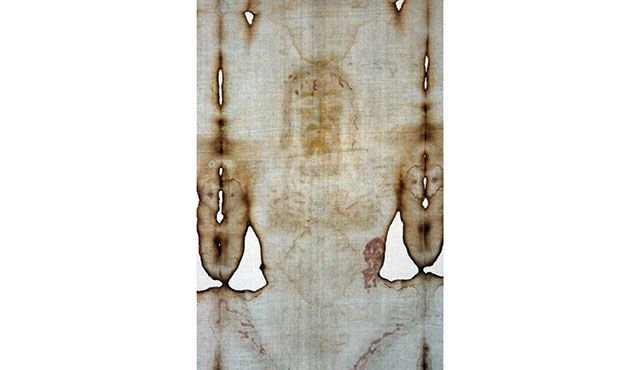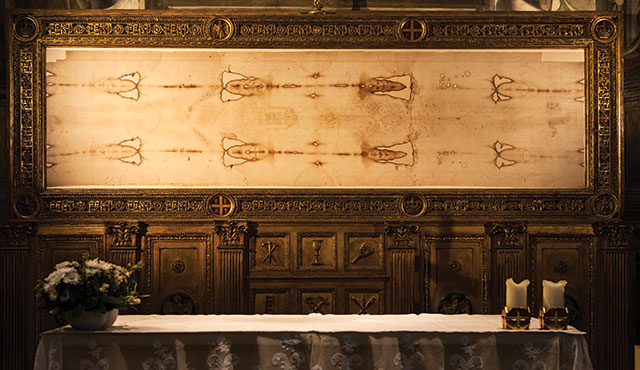If there is one individual largely responsible for unveiling the mysteries around the Shroud of Turin in the last 40 years, it is Ian Wilson. Wilson, an Oxford-educated writer and historian, spoke at Christ Cathedral’s Freed Theater on Oct. 6 at an event sponsored by the Shroud Center of Southern California.
Ian Wilson has been one of the foremost historical experts on the Shroud of Turin since 1978,” noted Fr. Robert J. Spitzer, SJ. Fr. Spitzer’s own interest in the Shroud stemmed directly from Wilson’s reports and publications. “Wilson was one of the original documenters of the Shroud’s journey, and continues to be on the forefront of Shroud research who demands a response from skeptics in the academic community,” Spitzer said.
In 1978, Wilson earned an international reputation with the publication of his book, “The Shroud of Turin: The Burial Cloth of Jesus Christ?” Wilson painstakingly detailed the purported historical journey of the Shroud in the book. “Wilson’s itinerary of the Shroud’s movement from Jerusalem to Edessa to Constantinople and ultimately to France and Italy complements scientific evidence of the same journey,” Fr. Spitzer said.
The Shroud, which has been kept in Turin since 1578, is a 14 ft. long by 3 ½ ft. piece of linen cloth woven in a herringbone twill. It contains a faded double image of the front and back of a man who appears to have undergone a trauma akin to the passion and death of Jesus, as documented in the Gospels.
In 1898, amateur photographer Secondo Pia photographed the Shroud and discovered in developing his photographic negatives a positive image of the man on the Shroud. The find opened the door for newfound interest in the Shroud in the 20th century, leading to an extensive scientific study of the Shroud in 1978 by a team of Americans.
It was Wilson who helped bridge the historical gap between the first known public exhibition of the Shroud in Lirey, France in the 1350s to its purported origins in Jerusalem, particularly in a tomb owned by Joseph of Arimathea that contained the crucified body of Jesus for three days. Wilson believes the Shroud was mostly kept safeguarded in the East until around the fall of Constantinople during the Fourth Crusade in 1204.
One of Wilson’s most compelling – and controversial – theories suggests the Shroud was folded up in four for most of its history. In this way, only the faded image of the face of the fully figured man on the cloth would have been visible. For Wilson, this corresponds to the artistic legacy of the icon of the holy face of Christ, venerated in the West in the “veil of Veronica” devotion from the sixth station of the Cross, and the subject of Wilson’s 1991 book, “Holy Faces, Secret Places.”
Momentum toward advancing the Shroud’s authenticity halted in 1988 with the findings of a C-14 dating test, which analyzed a corner piece of the Shroud. Three separate labs identified the age of the flax from which the linen was harvested as between 1260-1390. While initially promoting a C-14 test, Wilson disagreed with the manner in which the test was conducted, he told O.C. Catholic.
It was Wilson’s 1998 book, “The Blood and the Shroud,” and a spike in scientific analyses that led to a revival in Shroud study, including reports that the C-14 sample was contaminated and contained material in addition to the original linen.
Among the scientists advocating further exploration is Dr. August Accetta, who founded the Shroud Center of Southern California in 1996. It was the Shroud that profoundly influenced Accetta’s return to the Catholic Church. The Shroud Center, located on the grounds of the Santiago Retreat Center in Silverado, contains a museum with interactive exhibits devoted to the layers of history, science, anthropology, and theology the Shroud contains. Ian Wilson’s presentation is the first in a series sponsored by the Shroud Center featuring pivotal international Shroud experts.
Wilson, now 77, whose other works include a study on Shakespeare (“Shakespeare: The Evidence”), a theory on the discovery of America before Columbus (“The Columbus Myth”), and the search for Noah’s Ark (“Before the Flood”), continuously finds himself returning to the Shroud. “The Shroud has survived kingdoms and buildings,” he told O.C. Catholic. “When you gaze upon it, it is just you and the Shroud.” It is that personal experience in 1973 that compelled Wilson, a convert to Catholicism, to pursue the Shroud as a topic of study.
Wilson is working on a new theory on how the Shroud ended up in France in the 14th century. While he is tight lipped on his exact present findings, he makes it a point to mention the relic was “safeguarded” throughout much of its history. Safeguarding is the only way the Shroud could have survived all these centuries, he said.“


